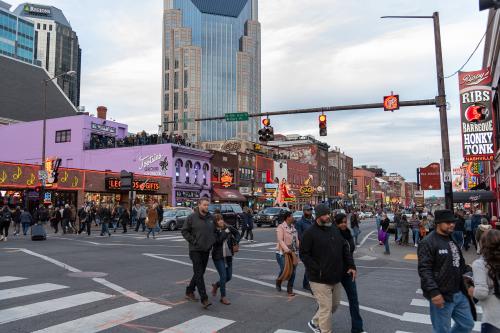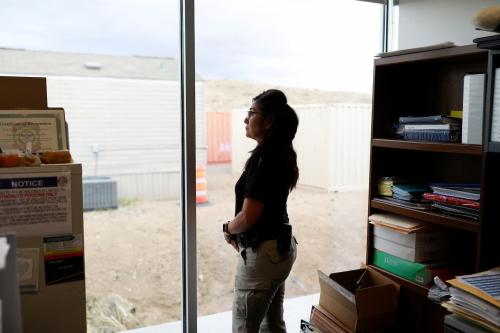Resentment against rapid population growth, aggravated by nine years of prosperity, has attained such a groundswell of support that citizens in two fast-growing states—Arizona and Colorado—are being asked to vote on ballot initiatives that appear to be partly aimed at slowing the overall population growth rates in those states. These initiatives require every locality to:
- Designate specific areas for future growth
- Have those designations approved by local voters
- Receive future voter approval for subsequent changes in the initially-approved growth areas
Neither initiative provides a formal agency to reconcile conflicts among the plans adopted by individual localities, although the Colorado initiative calls for voluntary plan coordination by each locality with its adjoining neighbors. It is understandable that citizens of these and other fast-growth states are concerned about the adverse impacts of recent rapid growth. But, as I argue in this policy brief, passage of these initiatives is unlikely to slow growth, and would likely generate undesirable economic and social conditions. A better citizen response to growth-related problems would be to adopt regionwide strategies based upon statewide planning goals.
POLICY BRIEF #67
Why People Seek to Limit Future Population Growth
Many residents of a particular area become upset by rapid growth primarily because it generates increased traffic congestion, absorption of open space, disruption of habitats, more air and water pollution, overcrowded schools and other infrastructures, and increased local tax burdens to pay for added infrastructure.
How can concerned citizens reasonably respond to the adverse impacts of growth? A natural reaction is to try to slow growth so these conditions at least do not get worse. Since land-use policies in America are determined by local governments, citizens of each locality lobby officials to limit the number of housing units permitted there each year. Such local anti-growth sentiments are strengthened by two other factors. Homeowners usually oppose any local developments they believe might reduce the market values of their homes, which are usually their largest assets. So they fight most additional multi-family or affordable housing and try to limit residential densities. These voters control the election of local officials, so most local officials adopt only policies that enhance the well-being of their own constituents, regardless of the impacts upon the rest of the region.
The second factor reinforcing the anti-growth sentiment is fiscal pressure on local officials to keep property taxes low. So they reject most proposed new developments that generate more local spending than they produce in local revenues. This means limiting new housing, especially relatively low-cost units for families with children, even though every community needs low-wage workers to serve its residents and businesses. Many such workers are compelled to live in deteriorated or overcrowded units in older core areas.
Not all communities in fast-growth regions are opposed to more growth. The governments of central cities and older suburbs often welcome additional development on vacant sites to offset losses of their residents and businesses to more distant suburbs. Both Phoenix and Denver contain large amounts of vacant land suitable for development; so they could capture growth diverted from hostile suburbs. Encouraging such development is a commendable goal of ballot initiatives on growth.
Attitudes Toward Growth
Growth-limiting sentiments are prevalent among many local residents and officials, particularly in fast-growing regions. As a result, citizens who care about growth can be roughly divided into four groups: local anti-growth advocates who do not care what happens to the population of the region as a whole but want to slow the growth of their own communities; regional anti-growth advocates who would like to slow the growth of the entire region, even though they usually declare they only want to change the way anticipated growth will occur; pro-growth advocates who would like to continue present unrestrained growth processes; and smart growth advocates who do not necessarily want to slow the growth of the whole region but would like to see it take different forms that produce fewer adverse conditions. (Of course, all parties say they are for “smart growth,” but they mean different things by that term.)
These four groups typically advocate different strategies. Local anti-growth advocates promote tough growth limits within their individual communities, but reject policies concerning the region as a whole. This approach tends to increase regional sprawl because developers blocked from building in anti-growth communities typically move farther out. Most pro-growth advocates want to maintain existing land-use and planning policies that have produced suburban sprawl for decades. Neither of these groups wants to change the present control of land-use planning by local governments. The strategies of the other two groups are discussed later.
Needs for Additional Growth and Development
Regions need to accommodate at least some new growth and development to remain economically stable and socially vibrant. The most basic reason is the natural increase of each region’s existing population—the number by which births exceed deaths each year. In the entire United States, annual natural increase is about 0.6 percent of the current population. In an average metropolitan area initially containing one million residents, this increase adds 6,000 persons per year, or about 2,264 households averaging 2.65 persons per household.
The second need for new development arises from replacing obsolete existing structures through new construction or renovation. If, for example, the average useful life of a structure is 100 years, then about one percent of existing structures need to be replaced annually in order to maintain the same amount of structures. In the hypothetical region initially containing one million residents, if households average 2.65 persons and each occupies a separate dwelling unit, there would be 377,360 occupied dwelling units, plus another 9,000 vacant units, for a total of 386,360 units. Replacing one percent of them annually requires building another 3,864 units.
The third potential need for new development is generated by immigration from abroad. About one million immigrants per year were legally admitted into the United States during the 1990s, plus another unknown number of illegal immigrants. A conservative estimate of illegals would be 100,000, totaling 1.1 million newcomers, which was about 0.4 percent of the existing population in the late 1990s. If these newcomers were distributed evenly across the nation, then a region initially containing one million residents would receive 4,000 immigrants each year, or about 1,500 new households. In the 1990s, however, over half of all immigrants from other countries went to California, New York, and Texas, and almost three-fourths to those states plus Florida, New Jersey, and Illinois.
Thus, total needs for new housing development or renovation from these three sources would equal 7,628 dwelling units, or about two percent of the initial housing inventory. These needs would be larger if the community replaced more than one percent of its dwellings each year, or received net immigration from abroad of more than 0.4 percent of the existing population, or smaller if the converse occurred.
If this hypothetical metropolitan area grew only from these three sources and residents did not move away at the end of one decade, it would have gained 10.4 percent in population and built 88,300 new dwelling units in a 10-year period—equivalent to 22.9 percent of its initial inventory. However, that inventory would have risen by only 40,400 units because obsolete units would have been removed or renovated. The region would also have added commensurate amounts of new stores, offices, streets, schools, and government facilities to accommodate its added population.
A fourth need for new development arises from migration into a region from other parts of the United States. For many decades, there has been a steady population flow from the Northeast and Midwest into the South and West. This flow generates above-average needs for new housing and facilities in many Southern and Western regions.
Migration from other states forms the major source of population growth in metropolitan areas such as Atlanta, Phoenix, Denver, Seattle, Orlando, and Washington, D.C. In fact, any region whose population grows more than 10 or 11 percent per decade is probably experiencing significant domestic migration. If annual domestic migration into a region equals one percent of the initial population, that doubles the typical rate of increase of a metropolitan area’s population to two percent per year. Consequently, such a region would experience a 21.9 percent increase in population in ten years. I estimate that the Phoenix metropolitan area, one of the nation’s fastest-growing, received an average of 2.47 percent net domestic migration per year from 1990-1996, and the Denver metropolitan area received 1.36 percent per year.
Growth often stimulates the economic dynamism of a region. More people expand the labor force and attract more employers, who in turn provide more jobs that attract still more newcomers. Growing areas often have higher wages and incomes than economically stagnant ones, and become large enough to contain clusters of firms in the same industries. Those firms can operate more efficiently than similar firms isolated in separate places.
These fundamental benefits of growth are today somewhat obscured by nine years of uninterrupted prosperity. People feel freer to think about aspects of their lives other than having good jobs and ample incomes, instead concerning themselves with issues like education, traffic, air and water quality, and recreational facilities—all of which deteriorate at least temporarily under fast-growth conditions.
Can Local Governments Really Slow Down Overall Regional Growth?
In my opinion, individual local governments cannot influence the overall growth rates of their regions or states by implementing local growth-control laws, statewide initiatives notwithstanding. Regional growth rates are determined by broad forces beyond the purview of any one or even several local jurisdictions. These forces include the region’s location in the nation, its climate, topography, demographics, physical size, natural resources, past investments made in it by specific industries and government agencies, and the national economic climate. So when one locality passes laws limiting future growth within its own boundaries, it does not affect the future growth rate of the overall region, but rather moves the region’s future growth to other localities, or to outlying unincorporated areas. Local growth limits, then, actually aggravate sprawl.
However, this conclusion depends upon the availability of some places within the region willing to accommodate more growth. If every square foot of land within a region lies within some incorporated locality, and if every locality adopts stringent growth limits, that could prevent additional growth from occurring anywhere within the region—at least legally. That combination of conditions has not existed in American metropolitan areas, though it almost prevails in parts of California.
Even if many communities adopt draconian limits on their own growth, there have always been other localities nearby willing to accept growth—or unincorporated areas without growth limits—or cities unable to stop overcrowding of their existing housing by newcomers. As noted above, central cities and older suburbs often want more growth to fill vacant sites or compensate for losses of people and firms.
Regional net migration—both foreign and domestic—is the major variable influencing the pace at which a metropolitan area grows. Therefore, slowing a region’s growth requires discouraging net in-migration. But regions gain a lot of in-migrants because the areas possess traits that attract newcomers looking for jobs and a desirable quality of life. Most of these traits are almost impossible to change through policy, especially local policy. Therefore, those seeking to slow a region’s growth can reduce its attraction to newcomers only by curtailing some of the very attributes that attracted them. Examples are reducing job opportunities, raising housing costs, increasing taxes, insufficiently funding public schools, and failing to finance adequate infrastructure. But all these negative changes will also harm existing residents. Therefore, few residents will support such policies unless they are billed as major taxpayer revolts—as was California’s Proposition 13, a successful 1978 initiative that limited taxes.
Moreover, it is more difficult to dissuade poor, unskilled immigrants from abroad than middle-income, educated in-migrants from the rest of the United States. Unskilled immigrants willingly accept housing, wages, and other provisions that educated migrants consider sub-standard, because immigrants regard such conditions as markedly superior to those that existed where they came from. Therefore, the less attractive a region is portrayed to newcomers, the more likely the mix of immigrants into it will shift toward higher percentages of poor and unskilled ones and lower percentages of middle-income, educated ones.
The Regional Anti-Growth Strategy
Some citizens upset by rapid growth have developed a strategy that appears to be aimed at slowing future population growth in a state or region as a whole, even though they claim they only want to increase local control over growth, slow tax increases, and reduce absorption of open land. That strategy is to require every sizable community within a state to adopt targeted growth limits that are difficult to revise, thereby eliminating a region’s “escape valve” consisting of some communities willing to accept growth, or at least unable to stop it. This approach is built into the state ballot initiatives this year in Colorado and Arizona.
This regional anti-growth strategy seems to assume that local voters who own homes will oppose most new construction of multi-family or affordable housing, favor local zoning rules that permit building of only expensive new homes, and limit residential densities. Regional anti-growth advocates appear to be counting on this conservatism to defeat future referenda aimed at increasing permissible new-growth areas within each region. Even if the authors of these two initiatives have not deliberately chosen to appeal to such parochial local motives, their proposals are likely to do so.
If statewide initiatives pass using this strategy, even if local communities adopt initial growth boundaries that contain enough vacant land to accommodate ten years’ worth of future growth (as in the Arizona initiative), that vacant land will eventually be developed, especially in fast-growth states like Arizona and Colorado. Then, additional future growth can only occur legally if citizens in each community subsequently vote for amendments that permit expanded growth areas or higher residential densities. Regional anti-growth advocates who support these two ballot initiatives are hoping such amendments will not pass, as shown by their requiring a four-fifths vote for approval of future changes in Arizona. That means a mere 21 percent of those local residents who vote can veto further growth, and that very few communities will be likely to welcome more growth.
However, if the regional anti-growth strategy substantially reduces total permits for future housing construction per year, housing prices in the entire region would probably be raised by affluent newcomers who continue to move there. Rising home values will benefit existing homeowners, who are the same voters that support preventing expansion of existing growth limits. But it will hurt renters (who make up more than one-third of the population and most of the low-income population), newcomers seeking to enter the area, and first-time homebuyers.
A second unintended and undesirable consequence will be the expansion of overcrowded slums in the Phoenix and Denver metropolitan areas. High housing prices do not stop low-income immigrants from abroad from entering a region if jobs are available there, because they are willing to double-up and triple-up in already overcrowded units. If not enough new housing affordable to low-and-moderate income households is built—and very little is currently being constructed anywhere—these immigrants will simply overcrowd existing housing, even though doing so is illegal. Already widespread in Southern California, such slums are now growing in Northern California as well.
These conditions might eventually reduce the growth of the entire region. But slower growth also means fewer new jobs, especially in the construction industry, which has long employed an above-average share of all workers in fast-growth regions like Phoenix and Denver. Those jobs support many ancillary jobs, which will simply not materialize, and higher housing prices will eventually deter major industrial and service firms from expanding into these regions.
What Strategy Should Smart Growth Advocates Support?
In many fast-growth regions, citizens quite reasonably upset by the negative impacts of growth, but also aware of its advantages, are searching for a strategy to cope with these two seemingly conflicting factors. Ballot initiatives like those in Colorado and Arizona focused solely on local actions are not the answer. They may not slow growth and are quite likely to generate undesirable side effects. But what strategy should these smart growth advocates support?
The first step is recognizing that trying to stop a region’s growth altogether—or even slow it dramatically—is neither feasible nor desirable. Moreover, regions such as Denver and Phoenix will inevitably suffer from some congestion and dislocations that irritate existing residents but do not discourage poor newcomers. The second step is realizing that localized responses cannot remedy the ills generated by regional growth. Coping with those ills requires regionwide policies marked by at least some effective cooperation among localities.
The third step is persuading the state legislature to create some type of regionwide agency with power to modify comprehensive plans developed at the local level. The state should also adopt a few basic growth-related policy goals, with all interested parties around the table, including local governments. These goals should address transportation, affordable housing, residential discrimination, habitat and environmental protection, open-space preservation, and land-use planning.
The next step is considering whether some type of urban growth boundary or utility district is appropriate for directing future development towards the region’s interior on vacant sites. If so, that spatial limit should be adopted on a regional basis, not piecemeal by dozens or hundreds of localities, nor imposed from the state or federal levels. The boundary should be flexible enough so that future population pressures will not raise housing prices to levels that are unattainable for newcomers and many existing residents.
There are two significant problems with the “smart growth” approach. First, adopting an effective strategy for regional growth management will require abandoning some politically sacred cows—particularly the untouchable sanctity of “local autonomy” over land-use planning. But localities have no real power over traffic congestion, air pollution, overall open-space absorption, and shortages of affordable housing, which all occur regionally. In fact, leaving the solutions entirely to localities makes the problems worse. Each locality tries to push all the social costs involved onto others, and avoids accepting a “fair share” of responsibility for truly effective remedies. It is time for citizens and politicians to accept this reality responsibly.
The second difficulty is that there is no guarantee that even a regional approach will resolve all the problems associated with growth, the most obvious being increased traffic congestion. Further population growth will generate many more vehicles on our roads. While we can neither lure enough people out of their cars into public transit nor build enough new roads to offset rising congestion, regional approaches have at least a chance of significantly ameliorating these and other problems associated with growth. In contrast, we already know that continuing to use purely local approaches cannot work.
Conclusions
Some citizens upset by rapid growth are promoting a strategy that appears at least partly aimed at slowing the future growth of rapid growth regions, particularly Phoenix and Denver. This strategy, ostensibly aimed at increasing local control over future growth, appeals to the parochial perspective of most local governments that focuses only on the well-being of their own residents, and therefore pushes the problems of growth onto other localities. If every locality throughout a state adopts that strategy, future growth will have nowhere to go.
Whether this strategy can overcome the basic attractions of fast-growing regions, which have drawn so many newcomers, has yet to be seen. Many California localities have long had stringent anti-growth laws, and that state’s population growth rate slowed dramatically in the 1990s. But the drop was caused by a severe recession in the early 1990s. During that decade, over two million mostly poor immigrants from abroad replaced over two million primarily middle class people who moved elsewhere in the United States. This experience appears to imply that widespread local anti-growth laws could slow a region’s future growth to only natural increases. But slowing growth by motivating middle class households to leave while poor ones continue to arrive is probably not the aim of those upset by growth—or anyone else.
Now that prosperity has returned to California, its net out-migration to the rest of the country has stopped, while net immigration from abroad continues. So California’s local anti-growth policies are not stopping growth, but are one of the major causes of soaring housing prices, extremely long commutes for many middle-income and poor households, low home ownership ratios, and burgeoning slums occupied by the poor. Arizona and Colorado are not California, but the passage of ballot initiatives in those states could move them closer to California’s conditions without solving their growth problems. A “smarter growth” strategy would be for citizens to stop trying to grapple with regional problems using local policy. Instead, responsible citizens should support some form of regional approach to managing future growth.



